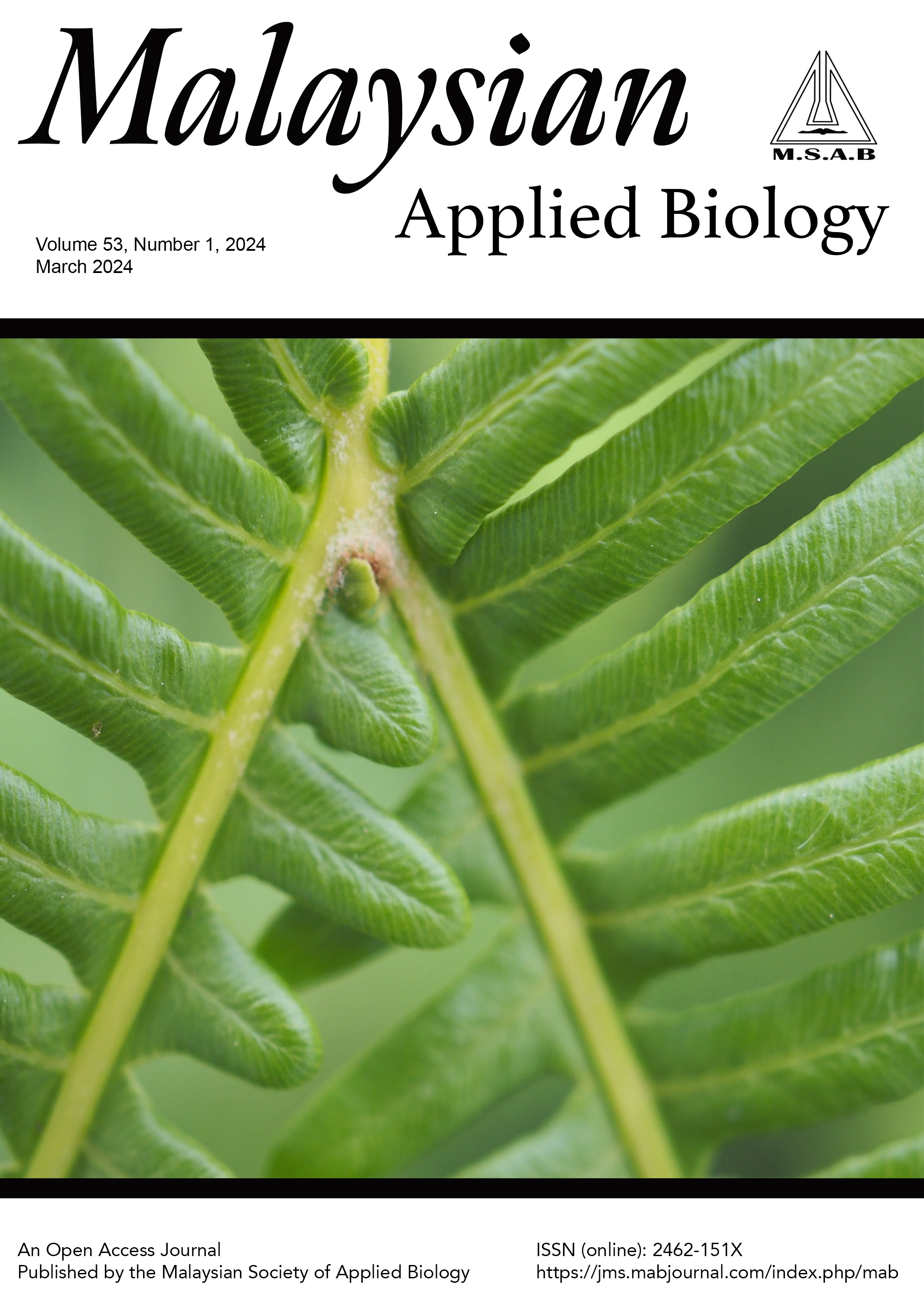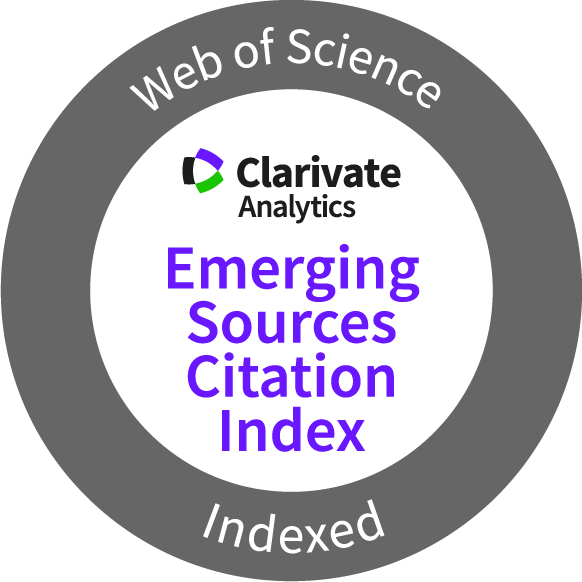Antibiofilm Efficacy and Mode of Action of Etlingera elatior Extracts Against Staphylococcus aureus
Keywords:
Biofilm, Antibiofilm, Etlingera elatior, Staphylococcus aureusAbstract
Staphylococcus aureus represents a major bacterial human pathogen that causes a wide variety of clinical manifestations. Various medicinal plants have been used to control its infection, however, the effect of Etlingera elatior on S. aureus biofilm is still uncertain. Thus, the objective of this study was to evaluate the antibacterial and antibiofilm efficacy of E. elatior extracts against S. aureus. Phytochemical screening was carried out to determine the presence of phenols, tannins, saponins, and alkaloids in different extracts (acetone, methanol, ethanol, and aqueous) of E. elatior. Antibacterial activities were determined by disk diffusion assay, minimum inhibitory concentration assay (MIC), and minimum bactericidal concentration assay (MBC) while antibiofilm activities were determined by crystal violet assay and Fourier-transform infrared (FTIR) spectroscopy. All the extracts were found to contain phenols, tannins, saponins, and alkaloids. Only acetone extract showed a high amount of saponins. Among all the extracts, acetone extract showed the widest inhibition zone (21.23±0.2 mm), lowest MIC (20 mg/mL), and lowest MBC (50 mg/mL) values. The acetone extract also showed the highest antibiofilm activities at all biofilm stages (6 hr: 12%-31%; 12 hr: 20%-36%; 18 hr: 27%-32%; 24 hr: 5%-46%). Further analysis with FTIR spectroscopy revealed spectral changes associated with proteins (1700–1400 cm-1), phospholipids, and polysaccharides (1300–700 cm-1) in S. aureus biofilm following the treatment with 200 mg/mL of E. elatior extracts. In conclusion, E. elatior is a potential source of antibacterial and antibiofilm agents to control S. aureus infections. Changes in the composition of proteins, phospholipids, and polysaccharides may mediate the biofilm inhibition by E. elatior extracts. The acetone extract of E. elatior may be useful for various applications such as antimicrobial topical cream and wound dressing.
Downloads
Metrics
References
Anzian, A., Muhialdin, B.J., Mohammed, N.K., Kadum, H., Marzlan, A.A., Sukor, R. & Meor Hussin, A.S. 2020. Antibacterial activity and metabolomics profiling of torch ginger (Etlingera elatior Jack) flower oil extracted using subcritical carbon dioxide (CO2). Evidence-Based Complementary and Alternative Medicine, 2020: 4373401. DOI: https://doi.org/10.1155/2020/4373401
Bazargani, M.M. & Rohloff, J. 2016. Antibiofilm activity of essential oils and plant extracts against Staphylococcus aureus and Escherichia coli Biofilms. Food Control, 61: 156-164. DOI: https://doi.org/10.1016/j.foodcont.2015.09.036
Bhattarai, D., Worku, T., Dad, R., Rehman, Z.U., Gong, X. & Zhang, S. 2018. Mechanism of pattern recognition receptors (prrs) and host pathogen interplay in bovine mastitis. Microbial Pathogenesis, 120: 64-70. DOI: https://doi.org/10.1016/j.micpath.2018.04.010
Bougarn, S., Cunha, P., Harmache, A., Fromageau Angélina, Gilbert, F.B. & Rainard, P. 2010. Muramyl dipeptide synergizes with Staphylococcus aureus lipoteichoic acid to recruit neutrophils in the mammary gland and to stimulate mammary epithelial cells. Clinical and Vaccine Immunology, 17(11): 1797-1809. DOI: https://doi.org/10.1128/CVI.00268-10
Chan, E.W.C., Lim, Y.Y. & Wong, S.K. 2011. Phytochemistry and pharmacological properties of Etlingera elatior: A review. Pharmacognosy Journal, 3(22): 6-10. DOI: https://doi.org/10.5530/pj.2011.22.2
Davis, R. & Mauer, L.J. 2010. Fourier transform infrared (FTIR) spectroscopy: A rapid tool for detection and analysis of foodborne pathogenic bacteria. Current Research, Technology and Education Topics in Applied Microbiology and Microbial Biotechnology, 2: 1582-1594.
Derbel, H., Elleuch, J., Mahfoudh, W., Michaud, P., Fendri, I. & Abdelkafi, S. 2023. in vitro antioxidant and anti-inflammatory activities of bioactive proteins and peptides from Rhodomonas sp. Journal of Applied Sciences, 13: 3202. DOI: https://doi.org/10.3390/app13053202
Dong, G., Liu, H., Yu, X., Zhang, X., Lu, H., Zhou, T. & Cao, J. 2017. Antimicrobial and antibiofilm activity of tannic acid against Staphylococcus aureus. Natural Product Research, 32(18): 2225-2228. DOI: https://doi.org/10.1080/14786419.2017.1366485
Famuyide, I.M., Aro, A.O., Fasina, F.O., Eloff, J.N. & McGaw, L.J. 2019. Antibacterial and antibiofilm activity of acetone leaf extracts of nine under-investigated South African Eugenia And Syzygium (Myrtaceae) species and their selectivity indices. BMC Complementary and Alternative Medicine, 19: 141. DOI: https://doi.org/10.1186/s12906-019-2547-z
Guzzo, F., Scognamiglio, M., Fiorentino, A., Buommino, E. & D'Abrosca, B. 2020. Plant derived natural products against Pseudomonas aeruginosa and Staphylococcus aureus: Antibiofilm activity and molecular mechanisms. Molecules, 25(21): 5024. DOI: https://doi.org/10.3390/molecules25215024
Hamdan, H.F., Zulkiply, N. & Yahya, M.F.Z.R. 2023. Control strategies of Staphylococcus aureus and methicillin-resistant Staphylococcus aureus (MRSA) biofilms: A review. Science Letters, 17(2): 33-49.
Isa, S.F.M., Hamid, U.M.A. & Yahya, M.F.Z.R. 2022. Treatment with the combined antimicrobials triggers proteomic changes in P. aeruginosa-C. albicans polyspecies biofilms. ScienceAsia, 48(2): 215-222. DOI: https://doi.org/10.2306/scienceasia1513-1874.2022.020
Johari, N.A., Aazmi, M.S. & Yahya, M.F.Z.R. 2023. FTIR spectroscopic study of inhibition of chloroxylenol-based disinfectant against Salmonella enterica serovar Thyphimurium biofilm. Malaysian Applied Biology, 52(2): 97-107. DOI: https://doi.org/10.55230/mabjournal.v52i2.2614
Johari, N.A., Amran, S.S.D., Che Man, C.A.I., Raja Yahya, M.F.Z. & Kamaruzzaman, A.N.A. 2020. Anti-biofilm potential and mode of action of Malaysian plant species: A review. Science Letters, 14(2): 34-46. DOI: https://doi.org/10.24191/sl.v14i2.9541
Kamaruzzaman, A.N.A., Mulok, T.E.T.Z., Nor, N.H.M. & Yahya, M.F.Z.R. 2022. FTIR spectral changes in Candida albicans biofilm following exposure to antifungals. Malaysian Applied Biology, 51(4): 57-66. DOI: https://doi.org/10.55230/mabjournal.v51i4.11
Karuppiah, P. & Rajaram, S. 2012. Antibacterial effect of Allium sativum cloves and Zingiber officinale rhizomes against multiple-drug resistant clinical pathogens. Asian Pacific Journal of Tropical Biomedicine, 2(8): 597-601. DOI: https://doi.org/10.1016/S2221-1691(12)60104-X
Kurumisawa, T., Kawai, K. & Shinozuka, Y. 2021. Verification of a simplified disk diffusion method for antimicrobial susceptibility testing of bovine mastitis isolates. Japanese Journal of Veterinary Research, 69(2): 135-143.
Lachumy, S.J., Sasidharan, S., Sumathy, V. & Zuraini, Z. 2010. Pharmacological activity, phytochemical analysis and toxicity of methanol extract of Etlingera elatior (Torch Ginger) flowers. Asian Pacific Journal of Tropical Medicine, 3(10): 769-774. DOI: https://doi.org/10.1016/S1995-7645(10)60185-X
Miklasińska-Majdanik, M., Kępa, M., Wojtyczka, R., Idzik, D. & Wąsik, T. 2018. Phenolic compounds diminish antibiotic resistance of Staphylococcus aureus clinical strains. International Journal of Environmental Research and Public Health, 15(10): 2321. DOI: https://doi.org/10.3390/ijerph15102321
Othman, N.A. & Yahya, M.F.Z.R. 2019. In silico analysis of essential gene and non-homologous proteins in Salmonella typhimurium biofilm. Journal of Physics: Conference Series, 1349: 012133. DOI: https://doi.org/10.1088/1742-6596/1349/1/012133
Rao, N., Mittal, S. & Menghani, E. 2012. Screening of antioxidant potential of Citrullus colocynthis methanolic extract. Journal of Chemical and Pharmaceutical Research, 4(5): 2507-2511.
Saudah, Zumaidar, Darusman, Fitmawati, Roslim, D.I., Juliantari, E., Ernilasari & Walil, K. 2022. Genetic diversity of Bak-Kala (Etlingera elatior (Jack) R.M. SM.) in Aceh Province, Indonesia. SABRAO Journal of Breeding and Genetics, 54(3): 502-511. DOI: https://doi.org/10.54910/sabrao2022.54.3.4
Sheikhi, M. & Mohammadi-Sichani, M. 2019. Antibiofilm and antibacterial activity of Urginea maritima against Staphylococcus aureus and Pseudomonas aeruginosa. Hormozgan Medical Journal, 23(4): e92566. DOI: https://doi.org/10.5812/hmj.92566
Sikora A. & Zahra F. 2023. Nosocomial Infections. In: StatPearls [Internet]. StatPearls Publishing, Treasure Island (FL).
Wijekoon, M.M.J.O., Bhat, R., Karim, A.A. & Fazilah, A. 2013. Chemical composition and antimicrobial activity of essential oil and solvent extracts of torch ginger inflorescence (Etlingera elatior Jack.). International Journal of Food Properties, 16(6): 1200-1210. DOI: https://doi.org/10.1080/10942912.2011.579674
Yaacob, M.F., Murata, A., Nor, N.H.M., Jesse, F.F.A. & Yahya, M.F.Z.R. 2021. Biochemical composition, morphology and antimicrobial susceptibility pattern of Corynebacterium pseudotuberculosis biofilm. Journal of King Saud University-Science, 33(1): 101225. DOI: https://doi.org/10.1016/j.jksus.2020.10.022
Yahya, M.F.Z.R., Alias, Z. & Karsani, S.A. 2018. Antibiofilm activity and mode of action of DMSO alone and its combination with afatinib against Gram-negative pathogens. Folia Microbiologica, 63: 23-30. DOI: https://doi.org/10.1007/s12223-017-0532-9
Yahya, M.F.Z.R., Ibrahim, M.S.A., Ibrahim, Zawawi, W.M.A.W.M. & Hamid, U.M.A. 2014. Biofilm killing effects of Chromolaena odorata extracts against Pseudomonas aeruginosa. Research Journal of Phytochemistry, 8(3): 64-73. DOI: https://doi.org/10.3923/rjphyto.2014.64.73
Yu, S., Zhu, X., Zhou, J. & Cai, Z. 2018. Biofilm inhibition and pathogenicity attenuation in bacteria by Proteus mirabilis. Royal Society Open Science, 5(4): 170702. DOI: https://doi.org/10.1098/rsos.170702
Zawawi, W.M.A.W.M, Ibrahim, M.S.A., Rahmad, N., Hamid, U.M.A. & Yahya, M.F.Z.R. 2020. Proteomic analysis of Pseudomonas aeruginosa biofilm treated with Chromolaena odorata extracts. Malaysian Journal of Microbiology, 16(2): 124-133. DOI: https://doi.org/10.21161/mjm.190512
Zulkiply, N., Ramli, M.E. & Yahya, M.F.Z.R. 2022. In silico identification of antigenic proteins in Staphylococcus aureus. Journal of Sustainability Science and Management, 17(2): 18-26. DOI: https://doi.org/10.46754/jssm.2022.02.002
Published
How to Cite
Issue
Section
Any reproduction of figures, tables and illustrations must obtain written permission from the Chief Editor (wicki@ukm.edu.my). No part of the journal may be reproduced without the editor’s permission
Funding data
-
Universiti Teknologi MARA
Grant numbers Pembiayaan Yuran Penerbitan Artikel





















